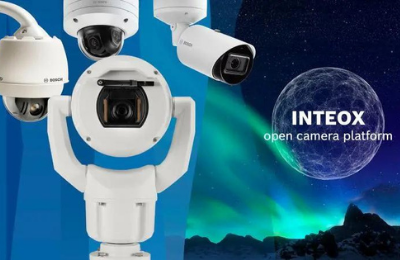
The development of video technology according to Bosch in 2020
Today, security is much more than creating a safe environment. Of course, the protection of people and property remain top priorities, but the Internet of Things (IoT) and increasing connectivity are changing and expanding the role of security devices.
Built-in intelligence and customizable solutions on an open platform
The industry needs to understand that security devices have far more potential than simply creating a safe and secure environment. These devices are sensors in a grid, able to provide valuable data that can be analyzed and used in new, beneficial ways. To take full advantage of this, the security and safety industry must be ready for change. Bosch is leading by example. Since 2016, Bosch has offered built-in Video Analytics as standard on all its IP cameras. In 2020, Bosch will launch INTEOX – a new camera platform designed to modernize the market.
Powerful systems start with built-in intelligence as standard. Besides protecting people and property, future-facing video security solutions need to deliver a parallel performance as intelligent sensors with the ability to extract invaluable data. Onboard Video Analytics acts as the 'brains' of a security system, using metadata to add sense and structure to captured video footage. This enables cameras to understand what they’re seeing and alert if there are threats the moment they happen. These insights help businesses to improve safety, increase efficiency, reduce costs, and create new value beyond security.
The next step in building powerful and efficient systems is the ability to tailor Video Analytics or security solutions to meet specific customer requirements. That’s why Bosch added Camera Trainer based on machine learning technology to all its cameras that feature built-in Intelligent Video Analytics. This enables system integrators to tailor Bosch built-in Intelligent Video Analytics to detect objects or situations that matter most to their customers. This fits perfectly in today’s market as there is no ‘one-size-fits-all’ when it comes to protecting people and property or delivering data for business intelligence. Bosch believes that the ability to train the camera is the next logical step in high-end video security. Because the more a video security camera knows and can learn, the more accurately and application-specifically it can function.
In 2020 INTEOX will take future solutions to the next level
INTEOX is based on an approach that has proven itself successful in the PC and mobile marketplace and where many software and app developers have substantially increased the use and applications for customers and the industry. The INTEOX open platform combines built-in Intelligent Video Analytics from Bosch with superb performance, a commonly used open operating System (OS), and the ability to securely add software apps afterwards. It enables app developers and integration partners to easily develop unlimited software apps based on a common language. System integrators can easily customize their security solutions to meet specific and changing customer requirements by adding apps and deploy them into INTEOX cameras. This is all supported by the highest levels of data security and privacy protection, and the quality and simplicity that comes with working with Bosch. The INTEOX platform will power a completely new line-up of MIC, AUTODOME, FLEXIDOME and DINION fixed and moving cameras.
The customer advantage
By incorporating smart devices with built-in Video Analytics, like regular Bosch IP or INTEOX cameras, into integrated systems, integrators can tailor solutions for different environments. For example, in today’s office buildings Bosch IP cameras ensure that any attempt to enter the area by unauthorized individuals will automatically trigger the Bosch Video Management System to display video of the location at the operator workstation.
Data gathered by security devices throughout the office building will display on dashboards, showing all types of information to users – including occupancy, people counts, temperature thresholds, energy usage, and more.
Enforcing no parking zones, detecting blocked emergency exits or ensuring no one enters or leaves a building via an emergency exit are all measures that can increase the safety of employees and visitors inside the building.
Outside the office building, connected systems can be used to secure perimeters and to use data captured by video sensors to improve traffic flow, parking management, and intersection safety. For example, IP cameras with built-in Video Analytics act as sensors that alert to safety risks such as wrong way drivers and by detecting pedestrians in the road, as well as counting open parking spaces.
After hours, set alarm rules can detect a person approaching a perimeter fence or loitering around the premises and automatically alert security personnel of the discovery. This helps users keep vehicles and people moving safely and efficiently while gathering information on surrounding roadways and parking lots for data-driven decision-making.
As the proliferation of connected devices continues to grow, we must anticipate how this will change customer requirements and preferences. Extending security devices beyond their standard uses helps users address the challenges they face in their businesses and organizations. This approach will help to shape the future of security – one where the security department can make the transition from a pure cost center to a profit center.

